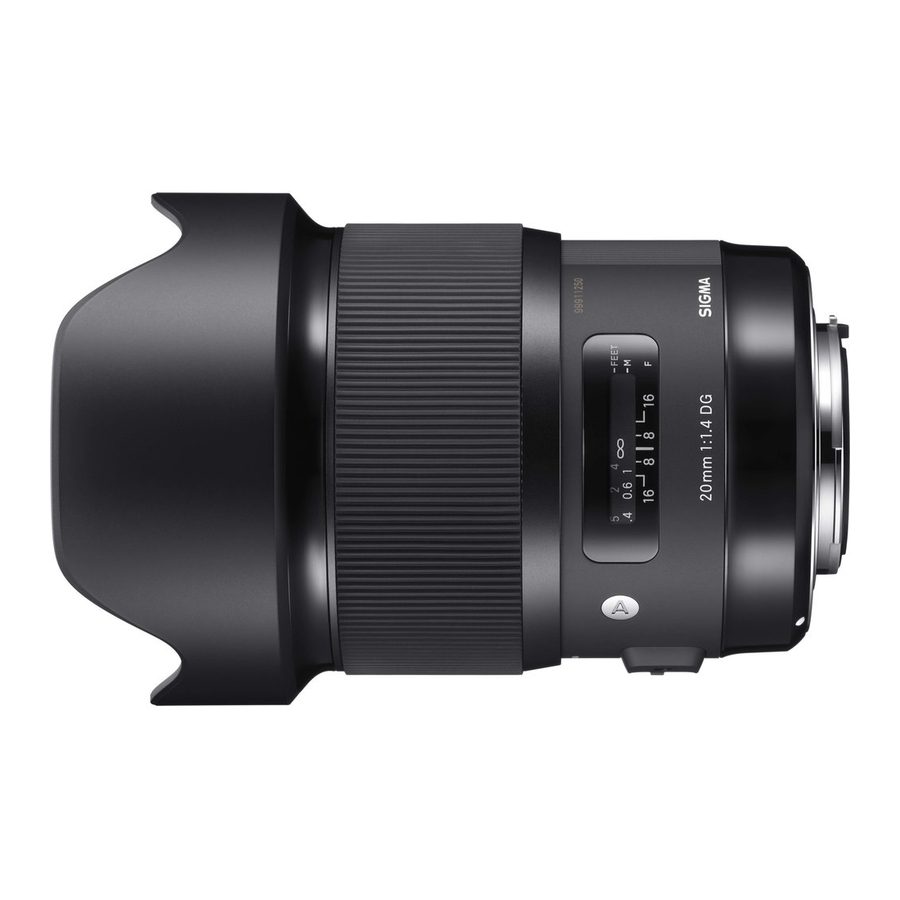Advertisement

In order to get the maximum performance and enjoyment out of your Sigma lens, please read this instruction booklet thoroughly before you start to use the lens.
DESCRIPTION OF THE PARTS (fig.1)

- Front cap
- Focus Ring
- Distance Scale
- Depth of Field Read Out Index
- Focus Index Line
- Focus Mode Switch
- Mount
NIKON AF TYPE CAMERAS
This lens functions in the same way as a G Type auto-focus Nikon lens (without an aperture ring). Functions may be restricted depending on the lens/camera combination. For more details, please refer to the camera's instruction manual.
ATTACHING TO THE CAMERA BODY
When this lens is attached to the camera body it will automatically function in the same way as your normal lens. Please refer to the instruction booklet for your camera body.
- On the lens mount surface, there are a number of couplers and electrical contacts. Please keep them clean to ensure proper connection. To avoid damaging the lens, be especially sure to place the lens with its front end down while changing the lens.
SETTING THE EXPOSURE MODE
The sigma lens functions automatically after mounting to your camera. Please, refer to the camera instruction book.
FOCUSING
This lens features Sigma's built-in Hyper Sonic Motor (HSM). The HSM enables quick and quiet autofocusing.
SIGMA and CANON
For autofocus operation, set the focus mode switch on the lens to the "AF" position (fig.2). If you wish to focus manually, set the focus mode switch on the lens to the "M" position (fig.3). You can adjust the focus by turning the focus ring.

NIKON
For autofocus operation, set the camera to AF mode and set the focus mode switch on the lens to the "AF" position (fig.2). If you wish to focus manually, set the focus mode switch on the lens to the "M" position (fig.3). You can adjust the focus by turning the focus ring.
- Please refer to camera's instruction manual for details on changing the camera's focusing mode.
- For Nikon mount, it is only possible to use AF with camera bodies which support motors driven by ultrasonic waves such as HSM. AF will not function if the camera body does not support this type of motor.
- When operating this lens in manual focus mode, it is recommended that correct focus be confirmed visually in the viewfinder rather than relying on the distance scale. This is due to possible focus shift resulting from extreme changes in temperature which cause various components in the lens to expand and contract. Special allowance is made for this at the infinity setting.
This lens also permits manual focusing even in the autofocus mode. While half pressing the shutter button, rotate the focus ring to adjust the point of focus.
Also, this lens can offer [Full-time MF function] (Manual Override) by rotating the focus ring of the lens while auto focusing is in operation. The default setting of Full-time MF function varies for each mount.
| Mount | Full-time MF function | Available AF Mode |
| SIGMA, NIKON | ON | Single AF (AF-S, S) Continuous AF (AF-C, C) |
| CANON | OFF | Single AF (ONE SHOT) |
- When using USB DOCK (sold separately) and its dedicated software, "SIGMA Optimization Pro", it is possible to select Full-time MF function ON / OFF, You can also adjust the amount of ring rotation to operate Full-time MF function. For further information, please refer to the SIGMA Optimization Pro "Help" menu.
- SIGMA Optimization Pro can be downloaded free of charge from the following website: http://www.sigma-global.com/download/
DEPTH OF FIELD SCALE
The depth of field scale helps you to check the depth of field (the zone of sharpness) of your composition. For example in figure (4), the depth of field zone is shown when the aperture F16 is used.

FLASH PHOTOGRAPHY
The camera's built-in flash will cause barrel shadow if used with this lens. For best results, please only use an external flash unit.
PREVENTION OF FLARE AND GHOST
Because of the extremely wide angle of view of this lens, flare and ghosting may occur much more easily than with other lenses. When you take a picture with this lens, please pay special attention to flare and ghosting which can occur when shooting near or directly into the sun or other very bright lights.
BASIC CARE AND STORAGE
- Avoid any shocks or exposure to extreme high or low temperatures or to humidity.
- For extended storage, choose a cool and dry place, preferably with good ventilation. To avoid damage to the lens coating, keep away from mothballs or naphthalene gas.
- Do not use thinner, benzine or other organic cleaning agents to remove dirt or finger prints from the lens elements. Clean by using a soft, moistened lens cloth or lens tissue.
- This lens is not waterproof. When you use the lens in the rain or near water, keep it from getting wet. It is often impractical to repair the internal mechanism, lens elements and electric components damaged by water.
- Sudden temperature changes may cause condensation or fog to appear on the surface of the lens. When entering a warm room from the cold outdoors, it is advisable to keep the lens in the case until the temperature of the lens approaches room temperature.
TECHNICAL SPECIFICATIONS
| Lens construction | 11 – 15 |
| Angle of View | 94.5° |
| Minimum Aperture | 16 |
| Minimum Focusing Distance | 27.6cm (0.906 ft) |
| Magnification | 1:7.1 |
| Dimensions Dia.×Length | 90.7g129.8mm (3.57g5.11in) |
| Weight | 950g (33.5oz) |
Dimensions and weight include the SIGMA mount.

Documents / Resources
References
Download manual
Here you can download full pdf version of manual, it may contain additional safety instructions, warranty information, FCC rules, etc.
Advertisement

















Need help?
Do you have a question about the 20mm F1.4 DG HSM and is the answer not in the manual?
Questions and answers